Cronache
2010: The third ikkyo: aikido between the lamas - Finally: in the tatami
Indice articoli
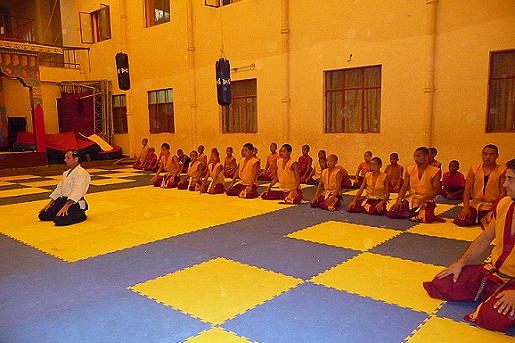 We've come to the following day: at three thirty in the afternoon the beginners' class, which has run for just a few months, is supposed to begin, but for the occasion the two courses will merge and we shall all do Aikido together for three hours.
We've come to the following day: at three thirty in the afternoon the beginners' class, which has run for just a few months, is supposed to begin, but for the occasion the two courses will merge and we shall all do Aikido together for three hours.
At the dojo, which has been accommodated within an internal courtyard sheltered by a light covering, I find the younger pupils already there, bent over the tatami and intent on cleaning it with the handle-less brooms that are typical of India.
Roberto introduces me to the students, and the effect of having before them the teacher of their own teacher is obviously exciting to these young men, charged with enthusiasm like sticks of dynamite.
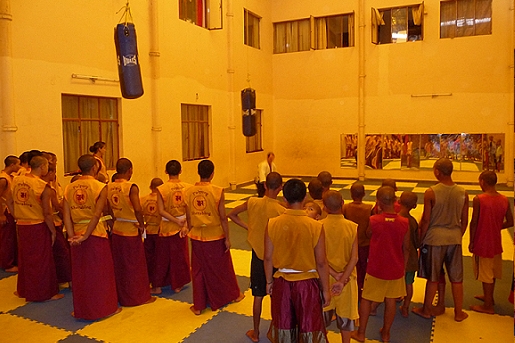 Their only possessions often are the clothes they wear; several of them were orphaned, and ignore where they were born; communication amongst them can sometimes be a struggle, because they speak the dialects of the remotest and most varied provinces of what once was the ancient and vast kingdom of Tibet.
Their only possessions often are the clothes they wear; several of them were orphaned, and ignore where they were born; communication amongst them can sometimes be a struggle, because they speak the dialects of the remotest and most varied provinces of what once was the ancient and vast kingdom of Tibet.
The young monks study hard and are tempered by the austere style of living at the monastery, to which many of them were not brought by vocation. As it turns out, not even participation to this course was decided by them, but by their teachers.
They're pure as crystals, and have light shining through their eyes; on this day, an opportunity has been opened to them that in their view is extraordinary. All of this is manifest without any words being spoken.
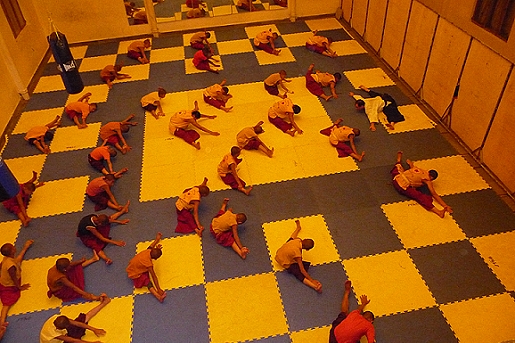 As soon as Roberto gets them started on their habitual "free-form warm-up", my jaw drops in amazement: what actually begins is a whirlwind of acrobatics of so extreme a degree of spontaneity and daringness we might as well call it sheer recklessness.
As soon as Roberto gets them started on their habitual "free-form warm-up", my jaw drops in amazement: what actually begins is a whirlwind of acrobatics of so extreme a degree of spontaneity and daringness we might as well call it sheer recklessness.
I'm astounded by wild stretching exercises I see: in one of them one youth is tugged and pulled at from both sides by two companions, and seemingly must only do his utmost to survive the drawing and quartering.
One of them initiates a leapfrog merry-go-round as expiation for the punishment Roberto had inflicted the previous day, and thus not miss the first part of my lesson.
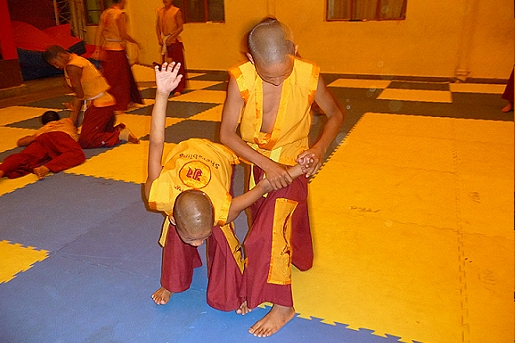 Comparing the live wire energy of these pupils to the dull apathy of our youths, reared on snacks and play stations, I also soon end up feeling galvanised by a peculiar enthusiasm I had never felt before.
Comparing the live wire energy of these pupils to the dull apathy of our youths, reared on snacks and play stations, I also soon end up feeling galvanised by a peculiar enthusiasm I had never felt before.
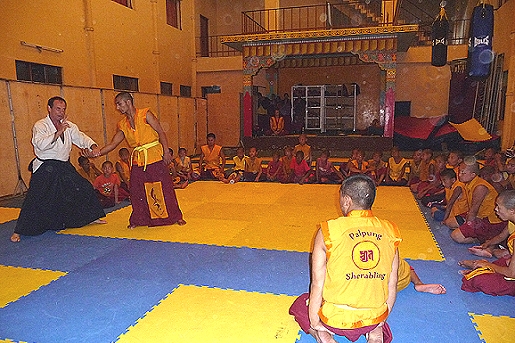 Without going into a chronicle of the actual training session, I shall simply say that their concentration and enthusiasm, their playful and vibrant energy made it so that my habitual didactic approach and manner of explaining produced incredible results.
Without going into a chronicle of the actual training session, I shall simply say that their concentration and enthusiasm, their playful and vibrant energy made it so that my habitual didactic approach and manner of explaining produced incredible results.
Notwithstanding the great obstacle of not being able to explain myself in words, but only by gestures, this prodigious array of athletes was unbelievably quick at taking in every movement I proposed, and every correction I made.
By the end of the lesson, I was by far the one who'd had the greatest fun.
As if we hadn't had enough already, all of a sudden an out of breath messenger arrives delivering a message in hurried wispers: the Tai Situ himself, accompanied by a contingent of solemn elders of the monastery, will be honouring us with his visit! A deep, unreal silence breaks up the young monks' joyous banter, giving turn to an attitude of utter respect and devotion.
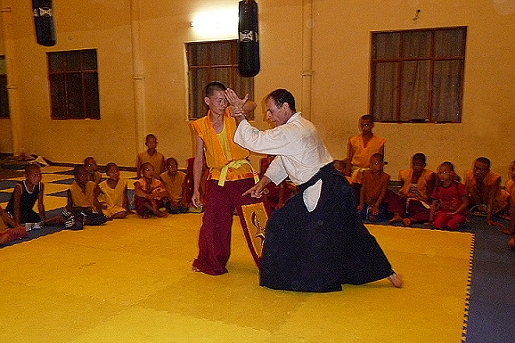 Having heard the report of my most favourable impression of the qualities I'd been able to observe at work with these pupils, as also of the groundwork Roberto had done, the Tai Situ suddenly relaxed into an informal, almost playful attitude. Similar behaviour came completely unexpected from a man of such rank, and was especially surprising to the young monks.
Having heard the report of my most favourable impression of the qualities I'd been able to observe at work with these pupils, as also of the groundwork Roberto had done, the Tai Situ suddenly relaxed into an informal, almost playful attitude. Similar behaviour came completely unexpected from a man of such rank, and was especially surprising to the young monks.
What we then witnessed in sheer amazement, was a performance by the Lama, who initiated with Roberto an exchange of martial techniques – he too being a dedicated student of the martial arts.
That first lesson was thus followed by another four, to the mutual and growing satisfaction of all involved.
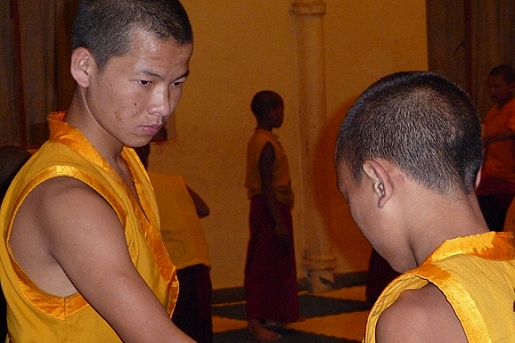 Their almost shameless aptitude to learning was almost provocation to me. As I came up with movements and situations of greater complexity, they would take the challenge as a stimulus, and with great curiosity, and a manifest desire to gratify me.
Their almost shameless aptitude to learning was almost provocation to me. As I came up with movements and situations of greater complexity, they would take the challenge as a stimulus, and with great curiosity, and a manifest desire to gratify me.
I mean – in the five days I was there I was able to go through the full Aikido 'syllabus' down to koshinage from all kinds of attack situations, ushirowaza included.
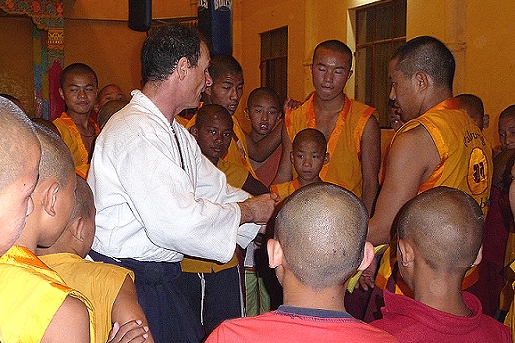 On the last day I was thus well curious to put to the test the progress we had made.
On the last day I was thus well curious to put to the test the progress we had made.
I thus ran an informal exam session on 6th kyu techniques and saw that fourteen of twenty in the advanced class would have passed.
Not my merit, certainly. The merit, rather, goes to the commendable foundation work laid down by Roberto, who is only an Aikido 5th kyu, and to the extraordinary talent of his pupils; quite possibly, it all came out of the imponderble, magical concord that quite spontaneously set in among them.
As a farewell, I gave each of them my visiting card, with the details of my dojo and of the dojo's website. Although it is only sporadically, the youths are allowed to use a computer so as to keep touch with the outside world: that very simple paper card and address were a real gift to them.
Proof of this came in the evening, when we were seated with our friends inside the plain tavern of the monastery and were joined there by Damchoe Thinley, who throughout had translated into Tibetan my very rudimentary English, and who, aged almost thirty (in Tibet the count begins from the time of conception) is the most mature of the young disciples. He bore a gift for me.
First he placed a pure white kata around my neck, then presented me with a book which contained reproductions of the Tai Situ's artwork, calligraphies, paintings, and photographs, which they had managed to buy by pooling together their meagre finances – their personal wealth really amounting to a few farthings. I was deeply moved. We shook hands and embraced by way of farewell – and who knows that this adventure might not have some kind of a sequel.
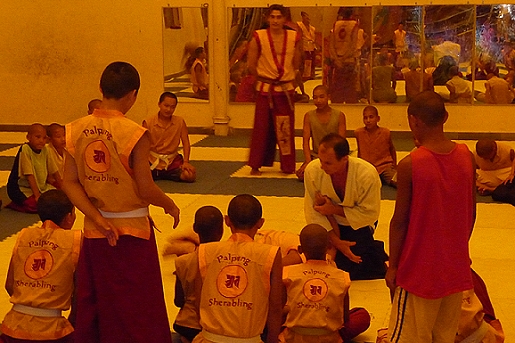 What has compelled me to write this article is the strong emotional charge I experienced and the indelible mark it impressed on me. Whatever may occur next, the fact is that something entirely special has taken place.
What has compelled me to write this article is the strong emotional charge I experienced and the indelible mark it impressed on me. Whatever may occur next, the fact is that something entirely special has taken place.
In the course of this exchange, I was able to combine my deep affection for the culture of Tibet with my passion and expertise in Aikido: as a teaching experience, it was unlike any I have had.
It is one thing to teach at your own dojo, to your pupils, or to convey technical skills to the people who pay a fee to join my seminars.
Here the exchange was on an even footing, pleasure for pleasure, learning satisfaction for teaching satisfaction, and all in the awareness that I was able to give something to these young men who, in spite of what we might also see as unfortunate circumstances, are still able to send out an incredible wave of optimism and positive energy.
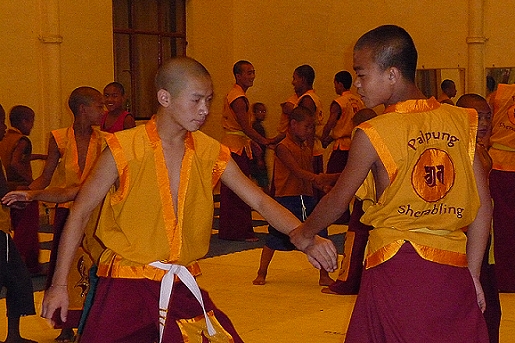 That group of young monks really did touch my heart, and the great distance is the only real obstacle there is between us. But then, we all know how enthusiasm can lend us wings.
That group of young monks really did touch my heart, and the great distance is the only real obstacle there is between us. But then, we all know how enthusiasm can lend us wings.
Montevecchi Ugo
Note:
Roberto Rivola published a book in 2008 on the question of Tibet and the violence perpetrated against this people. The title of the book is "Verità nascoste"; it was published at the author's expense and all proceeds goes a contribution to the Tibetan cause. The book may soon be re-edited by the publisher "Il Cerchio".

